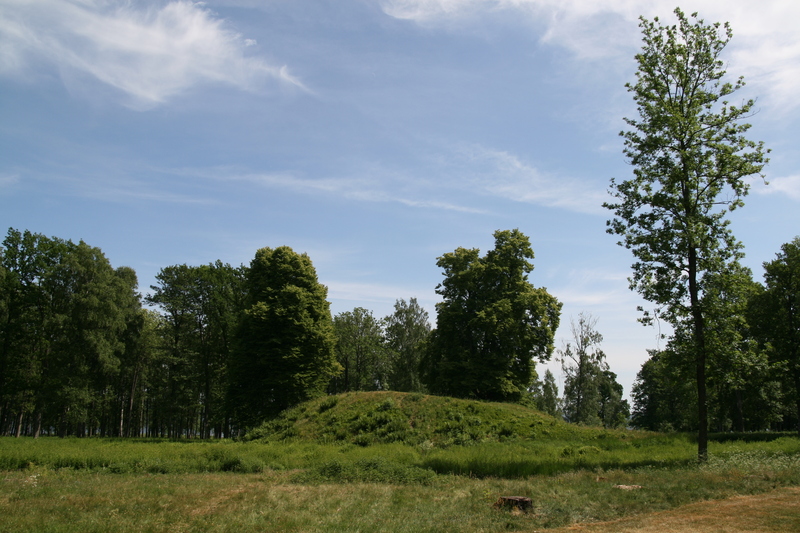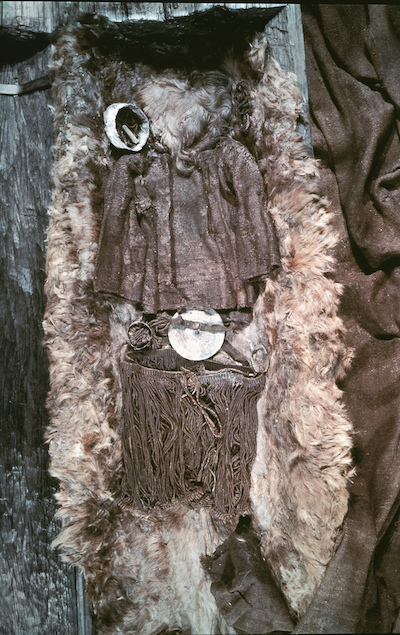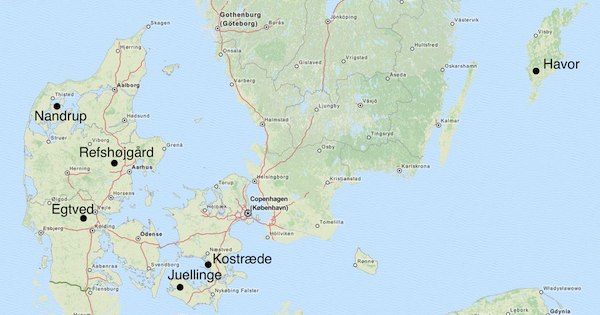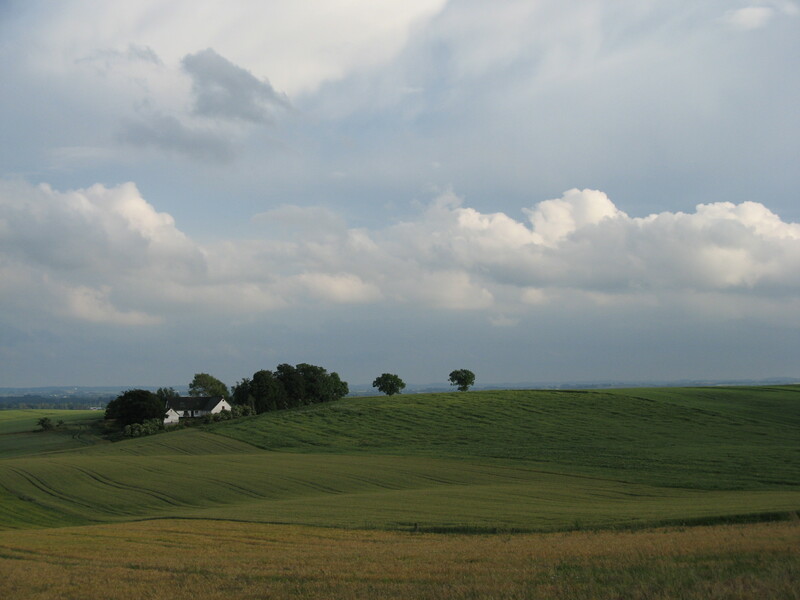Nordic grog

Viking age burial mound, Borre, Norway |
The origins of beer brewing in Scandinavia are lost in the mists of pre-history, and today we have very little evidence of how it began. We do know a little, however, mainly from archaeological excavations, and what little we know is both interesting and surprising.
For there to be beer, there must be agriculture, since otherwise there will be no grain for malting, and without malt there is no beer. In Norway agriculture seems to have arrived from Denmark and southeastern Sweden around 4000 BCE. The archaeological record is very sparse, so much of the evidence comes from pollen remains recovered from marshes and so on, showing vegetation changes and the introduction of barley.
So from about 4000 BCE there could be beer, but did they actually make beer? In the Middle East, where agriculture began, and from where it was transmitted to the north, there was beer brewing. Did the knowledge of brewing travel with the knowledge of agriculture? It certainly could have, but we don't know. However, a few, tantalizing pieces of evidence have, literally, been unearthed.
In 1921, farmer Peter Platz, wanted to remove the last parts of what had once been a huge burial mound on his land near Egtved in middle Jutland, Denmark. Digging into the mound he struck an oak coffin, in which was found the remains of a girl 16-18 years of age. She'd been buried in a short woolen skirt and sweater, with a big bronze disk at her midriff. Using dendrochronology, the burial has been dated to 1370 BCE.

Contents of the Egtved girl's coffin, Danish National Museum |
This find is of interest to us, because next to her feet was found a beaker made of birch bark, containing some dark residue. The contents have been analyzed, and showed traces of bog cranberries, cowberries, wheat, bog myrtle, and pollen. The pollen is likely from honey, so the drink appears to be a fermented mix of berries, wheat, and honey, flavoured with bog myrtle. Clearly, this is not beer, nor mead, nor a simple fruit wine, but rather more of a mix of all three. Patrick McGovern and his co-authors called it "Nordic grog" in a paper they wrote on the subject, and that seems as good a name as any.
Another interesting find comes from Nandrup, in north Jutland, from roughly the same period (some time 1500-1300 BCE). In the grave of a male warrior was found a jar, again with a dark residue on the bottom. In the jar was also found an amber 'button', probably a knob from a wooden lid that's since disintegrated. Two separate analyses found only pollen from lime trees, meadowsweet, and clover, which has been explained as deriving from honey. The jar in other words contained mead.
A third find is from Kostræde on southern Zealand, near Copenhagen, where a number of items were found in a pit. One of them was a strainer, in one of whose holes was found a small piece (6mm long) of brown material, probably left behind during straining. The find has been dated to 1100-500 BCE, so considerably later than the previous two finds. Analysis showed evidence of wine grapes, honey, birch and pine resin, plus, probably, juniper and bog myrtle. There were also weak indications of cereals, and further analysis may produce evidence for cereals.
This find is a little harder to interpret, but one part seems to have been resinated wine. In ancient times, pine resin was often used in wine to preserve it, especially for transport. This practice still continues in Greek retsina. There was also birch resin, apparently heated, which was interpreted as birch sap (which usually contains 1-2% sugar) boiled down to increase sugar content.
To summarize, the Kostræde find seems to be a mix of wine and mead, possibly also beer, since two ingredients known to be associated with beer were found in it, but this part is uncertain.

Location of finds (base map from Open Street Map) |
A fourth find was the tombs of four women, at Juellinge on the island of Lolland in southern Denmark, where a bronze bucket containing a dark residue was found in one the tombs. The find is dated to 200 CE. In this case, analysis found bog cranberry, lingonberry, probably grape wine, barley, pine resin, juniper, bog myrtle, and yarrow. The analysis indicated that honey was probably absent. So in this case we seem to be looking at a mix or resinated grape wine, fruit wine, and beer, flavoured with juniper, bog myrtle, and yarrow.
A fifth find is from Havor on southern Gotland in Sweden, where a hoard of precious metal was found in 1961, including a Roman bronze wine set. The hoard had been buried against the inner wall of a ring fort. Analysis in this case seems to indicate pure resinated wine, although it's possible that cereals were also present. The hoard appears to date from the first or second century CE.
There's also a sixth find, which dates all the way back to 2600 BCE, at Refshøjgård on Jutland, where a warrior grave yielded a beaker, again with residue. Microscopic analysis of the residue showed it to contain barley starch, which might indicate beer. Analysis of this find appears to have been more rudimentary, so very likely this is not the full story.
These are the only analyses of ancient Scandinavian fermented drinks that I'm aware of, but very likely there are more. What's particularly frustrating is the total absence of anything after about 200 CE. Six finds, some of them incompletely analyzed, is not a whole lot, but we can still do some interpretation and work out a few things.
The first thing to note is that northern Europeans imported wine from southern Europe. This is known from other sources as well, and appears to have been a sizeable trade. It's also clear that people were making mead, which is not surprising, given how simple the process is. All it takes is diluting honey with water until it gets to the point where the sugar content is low enough that the yeast that's naturally found in the honey can go to work.

Farm, northern Jutland |
Curiously, there is no definite evidence of what we today would call beer. The closest is McGovern's so-called "Nordic grog," which was a mix of wine, berries, mead, and beer. Possibly, the beer was sometimes left out, probably there was sometimes tree sap as well. Whether the cereals were malted is not known; it could be that they simply used unmalted grain. My guess is that this concoction was fermented by the yeast present in the wine and honey, so that there was no deliberate "infection" a la lambic, nor any deliberate adding of yeast.
From the available evidence, then, it doesn't seem like the Middle Eastern beer tradition was transmitted together with the knowledge of agriculture. If it had been, one would have expected at least one of the finds to actually contain beer. Of course, this is a very small data set, so nothing can be said for certain.
At some stage, the process must have begun by which the fermentables started separating out, so that wine, mead, and beer became separate drinks. Wine and mead probably were separate already, at least sometimes, judging from the evidence, but beer seems to have taken a long time to become established as a separate drink. It's difficult to say exactly why, but it could be because malting had not yet been invented, and/or because fruit and honey were necessary in order to get the beer to ferment.
That two of the grog finds included juniper is extremely interesting, since that's still used, to this day, in farmhouse ales in Norway, Sweden, Finland, Estonia, and Latvia. Can the tradition for using juniper in beer really extend that far back? I don't have enough evidence yet to say for certain, but it's at least possible.
The bog myrtle (Myrica gale) is likewise interesting, because we know that before the introduction of hops this was the main bittering agent used in beer in Scandinavia. Finding bog myrtle in three of the grogs is thus another indication that the tradition may have been continuous and stable over millennia. Again, evidence that it actually was is still missing.
The big question, of course, is how this mix of wine, berries, honey, and beer, flavoured with juniper and bog myrtle developed into something we would recognize as beer, and when. Unfortunately, I'm not in a position to answer that yet, and it's not clear that I ever will be. However, the next blog posts will look into what evidence we have from later times.
Sources
The above information was mostly taken from the paper A biomolecular archaeological approach to 'Nordic grog', Patrick E. McGovern, Gretchen R. Hall & Armen Mirzoian, Danish Journal of Archaeology, Volume 2, Issue 2, 2013.
Similar posts
The Early History of Hops
One of the biggest mysteries in the history of beer is where and when people started using hops in beer
Read | 2022-12-06 10:15
Malt, Mould, or Saliva
Michael Jackson famously classified beer into ale and lager based on how it was fermented, but this is a rather superficial feature
Read | 2025-12-03 15:35
Celtic Beer Yeast and Blue Cheese
A recent archaeological find caused much stir and writings in various newspapers, but everyone seems to have missed the most interesting part of the discovery
Read | 2021-11-01 08:59
Comments
Pivní Filosof - 2015-02-11 13:24:11
I've always thought that most early "beers" where more a food than a beverage. This seems to confirm it in some way. I can imagine prehistoric people cooking a mix of crushed grain, berries, fruit, herbs and honey and letting it ferment for a day or two. It would've been really nutritious!
Lars Marius - 2015-02-11 13:27:29
@Pivni: Certainly beer was more of a nutrition source before. You don't have to go very far back for that, barely even a century. Unless you mean literally, that the beer was more like a porridge than something completely fluid. Certainly some African and American beers seem more porridge-like. It might well be that these Nordic grogs were, too. We really don't know enough to say.
Dolfje deBont - 2019-09-13 14:13:56
I think agriculture in Western and Northern Europe started because men wanted beer. Gathering food was womens work, the only thing that could make men work the land was the craving for beer. In the earliest earthenware burnt barley grains have been found. Malt? Dolfje